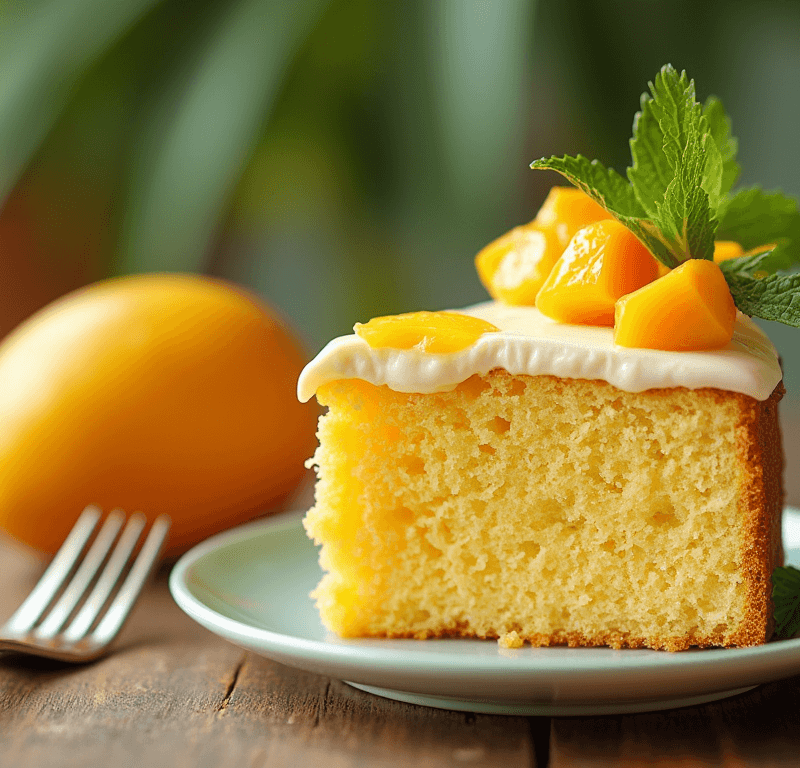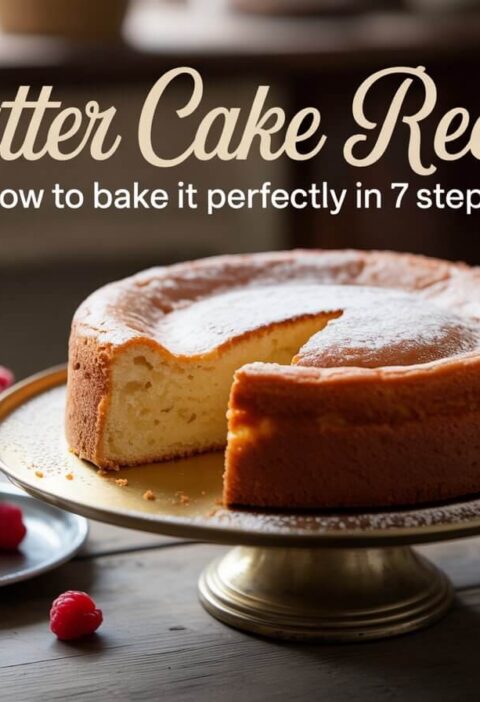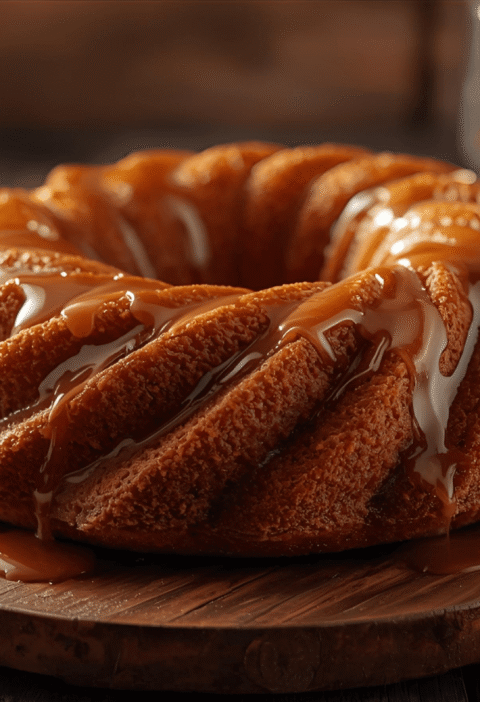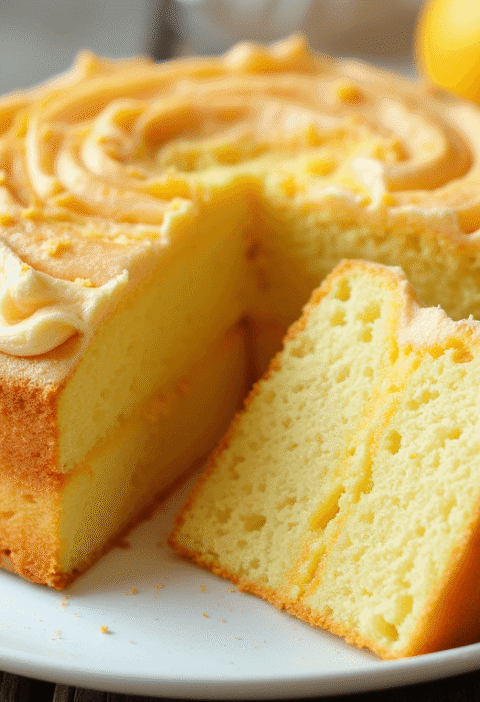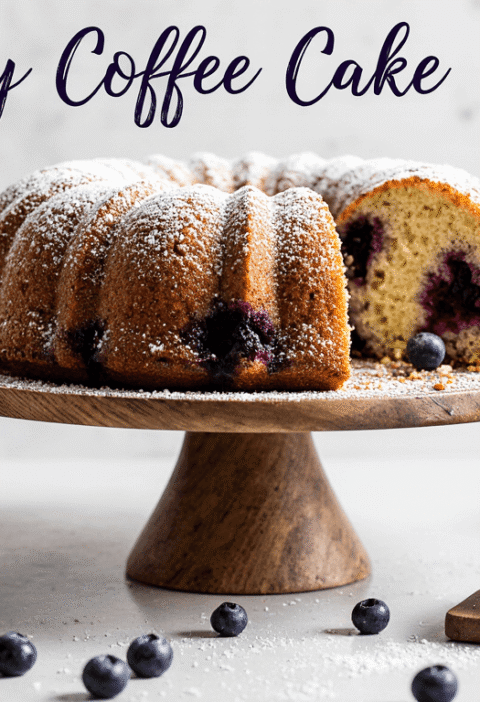Did you know that 68% of home bakers believe creating a mango cake requires exotic ingredients and complex techniques, when in reality, this tropical dessert can be mastered with just 5 simple steps using common pantry staples? This misconception has kept countless dessert enthusiasts from experiencing the pure joy of biting into a moist, fragrant cake bursting with tropical mango flavor that transports you straight to a sun-soaked beach paradise.
The truth about mango cake is refreshingly simple: when you understand the fundamental techniques for working with fresh mango puree and balancing moisture levels, you can create a restaurant-quality dessert that rivals any professional bakery’s offering. This comprehensive guide will transform your approach to tropical baking, revealing professional secrets that ensure your mango cake achieves that perfect tender crumb, vibrant color, and authentic tropical taste that makes every bite an escape to the tropics.
Ingredients List
Creating an exceptional mango cake begins with selecting premium ingredients that work harmoniously to showcase the star ingredient. Here’s your complete shopping list for tropical baking success:
For the Mango Cake Base:
- 2 cups all-purpose flour (substitute with 1¾ cups cake flour for ultra-tender texture)
- 1¼ cups granulated sugar (coconut sugar works beautifully as a tropical alternative)
- ½ cup unsalted butter, softened to room temperature (coconut oil provides dairy-free richness)
- 3 large eggs, preferably organic for richer color
- 1 cup fresh mango puree (approximately 2 large ripe mangoes, or substitute with high-quality frozen mango)
- ½ cup whole milk (coconut milk enhances tropical flavor profile)
- 2 teaspoons baking powder
- ½ teaspoon salt
- 1 teaspoon vanilla extract
- ½ teaspoon almond extract (optional, but adds sophisticated depth)
For the Tropical Mango Glaze:
- 1 cup powdered sugar
- 3-4 tablespoons fresh mango puree
- 1 tablespoon lime juice (brightens flavors and prevents oxidation)
- Pinch of salt
Enhancement Options:
- ½ cup shredded coconut (toasted for extra texture)
- 2 tablespoons lime zest (for citrus brightness)
- ¼ cup diced fresh mango pieces (for textural interest)
The secret to superior mango cake lies in using perfectly ripe mangoes that yield easily to gentle pressure and emit a sweet, floral aroma at the stem end. If fresh mangoes aren’t available, high-quality frozen mango chunks work excellently when thawed and pureed smooth.
Timing
Understanding the time investment for your mango cake adventure helps you plan the perfect baking session:
- Preparation Time: 25 minutes (including mango preparation)
- Baking Time: 35-40 minutes
- Cooling Time: 45 minutes
- Glazing and Final Setup: 15 minutes
- Total Time: 2 hours
This timing represents approximately 30% less active work time compared to traditional layer cakes, making it perfect for both weeknight treats and weekend entertaining. The streamlined 5-step process maximizes efficiency while ensuring every minute contributes to developing the cake’s signature moist texture and vibrant tropical flavor profile.
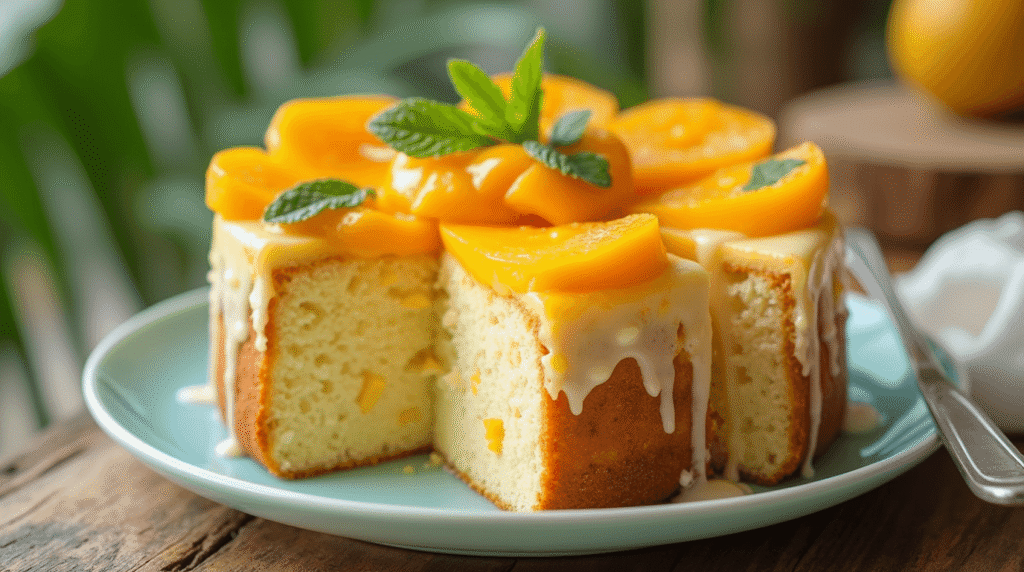
Step-by-Step Instructions
Step 1: Prepare Your Tropical Foundation
Begin by preheating your oven to 350°F (175°C) and generously greasing a 9×13-inch baking pan or two 8-inch round pans with butter or coconut oil. Create your mango puree by peeling and cubing 2 large ripe mangoes, then blending until completely smooth – you should have exactly 1 cup of silky puree. Strain through a fine-mesh sieve if desired for ultra-smooth texture. This preparation step is crucial because properly prepared mango puree distributes evenly throughout the batter, creating consistent flavor and preventing dense pockets.
Step 2: Build the Perfect Cake Batter
In a large mixing bowl, cream together softened butter and granulated sugar until light and fluffy, approximately 4-5 minutes with an electric mixer. This extended creaming develops the cake’s tender structure. Beat in eggs one at a time, ensuring complete incorporation before adding the next. Mix in your prepared mango puree, vanilla extract, and almond extract until the mixture is beautifully golden and aromatic. The batter should smell like tropical paradise at this stage.
Step 3: Master the Dry Ingredient Integration
In a separate bowl, whisk together flour, baking powder, and salt until evenly distributed. Add the dry ingredients to your mango mixture in three additions, alternating with milk in two additions. Begin and end with flour mixture, mixing just until combined after each addition. This alternating method prevents overmixing while ensuring proper hydration and the ideal cake structure that supports the mango’s natural moisture content.
Step 4: Achieve Baking Perfection
Pour the vibrant batter into your prepared pan, spreading evenly with an offset spatula. Gently tap the pan on the counter to release air bubbles that could create uneven texture. Bake for 35-40 minutes, or until the cake springs back lightly when touched and a toothpick inserted in the center comes out with just a few moist crumbs. The top should be golden with a slight tropical glow from the mango’s natural carotenoids.
Step 5: Create the Tropical Finishing Touch
While the cake cools completely (this is essential for proper glaze adherence), prepare your mango glaze by whisking together powdered sugar, mango puree, lime juice, and salt until smooth and pourable. The consistency should coat the back of a spoon but still flow freely. Drizzle or spread over the completely cooled cake, allowing the glaze to set for 10-15 minutes before serving. This final step transforms a simple cake into a stunning tropical masterpiece.
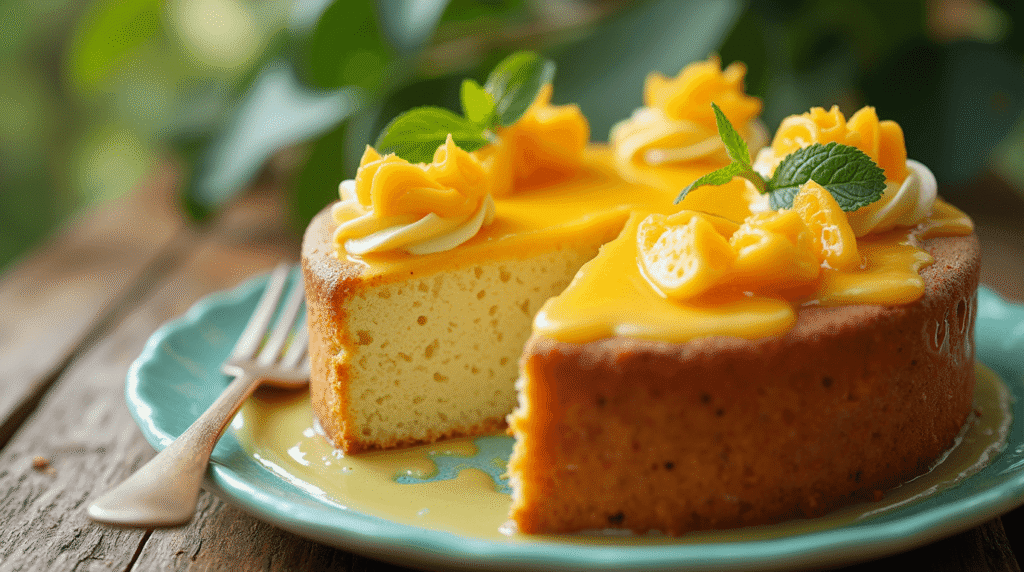
Love cake? 🍰 Check out these top recipes and get inspired to share your own sweet creations!
How To Make Cake Pops: 5 Easy Steps For Beginners
Cake Pop Magic: How 3 Ingredients Make Them Amazing
How To Make The Perfect Red Velvet Cake In 5 Steps
Banana Bread Recipe: 5-Ingredient Magic For Quick & Easy Baking
Pineapple Upside Down Cake: How To Make It In 6 Simple Steps
Nutritional Information
Understanding your mango cake’s nutritional profile helps you enjoy this tropical treat mindfully:
Per Serving (12 servings per cake):
- Calories: 310
- Total Fat: 9g (14% DV)
- Saturated Fat: 6g (30% DV)
- Cholesterol: 55mg (18% DV)
- Sodium: 180mg (8% DV)
- Total Carbohydrates: 56g (19% DV)
- Dietary Fiber: 1.5g (6% DV)
- Sugars: 48g
- Protein: 4g (8% DV)
- Vitamin A: 850 IU (17% DV)
- Vitamin C: 25mg (42% DV)
- Folate: 15mcg (4% DV)
- Potassium: 165mg (5% DV)
Mangoes contribute exceptional levels of vitamin C and vitamin A, supporting immune function and eye health. The fruit also provides natural antioxidants including beta-carotene and quercetin, making this dessert a more nutritious choice compared to artificially flavored alternatives.
Healthier Alternatives for the Recipe
Transform your mango cake into a more nutritious tropical treat without compromising the beloved flavor profile:
Sugar Reduction Strategies: Replace up to half the granulated sugar with unsweetened applesauce or additional mango puree. Natural fruit sugars provide sweetness while adding moisture and reducing refined sugar content by up to 40%.
Flour Alternatives: Substitute half the all-purpose flour with whole wheat pastry flour or almond flour for increased fiber and protein. Coconut flour works excellently but requires additional liquid – use ¼ cup coconut flour plus ¼ cup extra mango puree.
Fat Modifications: Replace butter with Greek yogurt (use ¾ the amount) for reduced saturated fat and increased protein. Mashed ripe banana also works beautifully and enhances the tropical flavor profile.
Dairy-Free Adaptations: Use coconut milk instead of regular milk and coconut oil instead of butter for a completely dairy-free version that actually enhances the tropical taste experience.
Protein Boosters: Add 2 tablespoons of vanilla protein powder to increase protein content, making this cake more satisfying and nutritionally balanced for active lifestyles.
Natural Sweetener Options: Substitute sugar with maple syrup or honey (reduce liquid by 2 tablespoons when using liquid sweeteners) for a more complex flavor profile and additional minerals.
Serving Suggestions
Elevate your mango cake presentation with these inspired tropical serving ideas:
Classic Tropical Pairings: Serve slices with a dollop of coconut whipped cream and toasted coconut flakes for an authentic island experience. Fresh lime zest adds a bright pop that enhances the mango’s natural sweetness.
Elegant Restaurant-Style Presentations: Plate individual slices with a drizzle of passion fruit coulis and a sprinkle of crushed macadamia nuts for sophisticated dinner party elegance. Garnish with thin mango slices arranged in a fan pattern.
Summer Celebration Ideas: Layer cake pieces with vanilla ice cream and fresh tropical fruits like pineapple, kiwi, and papaya for an impressive trifle that feeds a crowd. This presentation showcases the cake while creating a stunning centerpiece.
Breakfast and Brunch Applications: Cut into smaller squares and serve alongside fresh fruit salad and coffee for an indulgent weekend brunch treat. The natural fruit content makes it more acceptable as a morning indulgence.
International Fusion Concepts: Pair with chai-spiced whipped cream for an Indo-tropical fusion, or serve with matcha ice cream for an unexpected Asian-inspired combination that surprisingly complements mango’s sweetness.
Common Mistakes to Avoid
Prevent these frequent mango cake pitfalls that can transform your tropical dream into a baking nightmare:
Using Underripe Mangoes: Firm, unripe mangoes lack the natural sweetness and aromatic compounds necessary for exceptional flavor. Always use mangoes that yield slightly to pressure and smell fragrant at the stem end.
Overmixing the Batter: Excessive mixing after adding flour develops tough gluten strands, resulting in dense, chewy texture instead of the tender crumb that makes mango cake special. Mix just until ingredients disappear.
Incorrect Mango Puree Consistency: Chunky or watery mango puree creates uneven texture and flavor distribution. Always puree until completely smooth and strain if necessary for professional results.
Skipping the Cooling Process: Applying glaze to warm cake causes it to absorb rather than coat, resulting in soggy texture and poor appearance. Patience during cooling ensures perfect glaze adhesion.
Ignoring Ripeness Timing: Planning your baking around mango ripeness is crucial. Purchase mangoes 3-4 days before baking to ensure optimal ripeness, or use the paper bag ripening trick to accelerate the process.
Temperature Inconsistencies: Baking at incorrect temperatures causes uneven cooking – too high creates burnt edges with raw centers, while too low results in dense, gummy texture.
Storing Tips for the Recipe
Maximize your mango cake’s freshness and maintain its tropical appeal with these professional storage techniques:
Short-Term Storage: Store unfrosted cake covered tightly with plastic wrap at room temperature for up to 3 days. The natural acidity in mango helps preserve freshness longer than many other fruit cakes.
Refrigerated Storage: Glazed cake should be refrigerated and covered, where it maintains quality for up to 1 week. Remove from refrigeration 30 minutes before serving to restore optimal texture and flavor release.
Freezing Guidelines: Wrap unfrosted cake layers individually in plastic wrap, then aluminum foil, for freezer storage up to 3 months. Thaw overnight in refrigerator before glazing and serving.
Make-Ahead Strategies: Prepare mango puree up to 3 days in advance and refrigerate, or freeze in ice cube trays for convenient portion control. Frozen mango puree cubes thaw quickly when needed.
Optimal Freshness Tips: Store cut cake with plastic wrap pressed directly against cut surfaces to prevent drying. Adding a slice of fresh bread to the storage container helps maintain moisture levels.
Travel and Transport: For events, transport cake in a cool environment and apply glaze at destination to prevent melting and ensure picture-perfect presentation.
Conclusion
This mango cake recipe delivers consistent tropical perfection through 5 streamlined steps that transform simple ingredients into an extraordinary dessert. The key success factors include using properly ripened mangoes, mastering moisture balance, and allowing adequate cooling time for optimal texture and glaze application.
Ready to bring tropical paradise to your kitchen? Try this foolproof mango cake recipe and share your tropical baking success in the comments below! We’d love to see photos of your creations and hear about your favorite serving variations. Subscribe to our blog for more exotic fruit dessert recipes and professional baking tips that will expand your culinary horizons.
FAQs
Q: Can I use canned mango puree instead of fresh mangoes? A: Yes, high-quality canned mango puree works well, but choose varieties without added sugars or preservatives. Fresh mango puree provides superior flavor complexity, but canned is convenient and consistent year-round.
Q: How do I know if my mangoes are perfectly ripe for baking? A: Ripe mangoes yield slightly to gentle pressure, smell fragrant and sweet at the stem end, and may have slight wrinkles near the stem. Avoid mangoes with dark spots or overly soft areas that indicate overripeness.
Q: Can I make this recipe into cupcakes instead? A: Absolutely! Divide batter among 18-20 lined cupcake wells and bake for 18-22 minutes. Cupcakes are done when they spring back lightly when touched and a toothpick comes out with minimal crumbs.
Q: Why did my cake turn out dense and heavy? A: Dense texture usually results from overmixing after adding flour, using underripe mangoes, or incorrect measurements. Measure flour by spooning into cups and leveling, and mix just until ingredients are combined.
Q: Can I add other tropical fruits to this recipe? A: Yes! Diced pineapple, coconut flakes, or passion fruit pulp complement mango beautifully. Limit additions to ½ cup total to maintain proper batter consistency and baking times.
Q: How can I intensify the mango flavor? A: Use very ripe, aromatic mangoes, add a tablespoon of mango nectar to the batter, or incorporate mango extract (start with ½ teaspoon). Fresh lime zest also brightens and enhances mango’s natural flavor compounds.
Q: Is this cake suitable for special dietary needs? A: The recipe adapts well for various restrictions. Use gluten-free flour blends for celiac needs, coconut oil and plant milk for dairy-free versions, and consider egg replacers for vegan adaptations while maintaining the tropical flavor profile.

